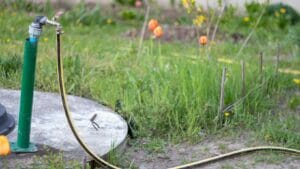
Welcome to our blog post on outside water faucets! We know plumbing can be a little intimidating, but now we’re here to break it all down into easy-to-understand bits. Today, we want to take a look at the different kinds of outdoor faucets and what they do. Whether you’re watering plants or washing the car, the right type of outside faucet sure comes in handy. So join us as we explore all your piping
Different types of valves
When it comes to outside water faucets, there are generally four types of valves that can be used: Ball valves, gate valves, shutoff valves, and frost-proof/anti-siphon ball valves. Each type of valve has its own advantages and disadvantages which is why knowing each type and its capabilities is essential when making the best selection for your particular needs.
Ball Valves – Ball valves are constructed using a very durable metal body material such as brass or stainless steel and typically have either a solid or split body design. A ball valve is commonly used for regulating the flow of water through a pipe since it provides an easy way to block off or pass along the liquid with just two switches (open/close). It’s also very reliable since it can restrict full flow while also allowing partial flow depending on how much pressure is applied to the handle.
Gate Valves – Gate valves are similar to ball valves in that they control the flow rate by blocking off or passing along liquid but instead use a disk-like gate that swings up and down in order to control the rate of flow. Gate valve designs typically consist of either bronze or stainless steel materials and offer more resistance against corrosion due to their solid construction.
Shutoff Valves – Shut off valves provide greater control over the flow rate compared to other kinds of outside water faucets with its capability to completely stop any liquid from flowing through it. This makes them ideal for instances where complete isolation between two ends of piping is needed such as during repairs on piping systems or when winterizing outdoor plumbing systems before cold weather. Most shutoff designs incorporate brass materials however some newer models use PEX plastic piping instead though these tend to be more expensive than traditional options.
Frost Proof/Anti Siphon Ball Valves – Frost proof ball valves offer protection against freezing temperatures while simultaneously controlling water pressure buildups within piping systems using an interior diaphragm within the valve housing itself which allows for precision adjustment capabilities at a much lower cost than traditional shutoff approaches. They are also designed with anti siphon features that make them ideal for outdoor sprinkler systems located close to residential areas where siphoning could potentially occur from neighboring property lines if not properly protected against this danger from occurring
Pipe fittings and connections
Pipe fittings and connections are an important part of any outdoor water faucet. The most commonly used type of outside faucet is the frost-free sillcock, which is designed to provide an anti-siphon and anti-freeze flow of water. However, there are other types of pipe connections that you can use to connect your outside faucet to the water line, depending on your location and the climate in which you live.
The most common type of pipes and fittings used are copper or PVC pipe, but different plastic materials may be used as well depending on where you live. The metals used to create these pipes will vary based on their usage and the climate in which you live, so it’s best to consult with a plumbing professional before deciding on what type of outside faucet connection you should use.
Pipe threading may be necessary if your PVC or copper pipe has threads that need to be connected in order for a watertight seal. Thread sealing generally uses Teflon tape or similar material in order to ensure that the connection is airtight and sealed correctly. Adaptors specifically designed for outdoor weather conditions are available if a standard threaded adapter won’t suffice for your needs.
Also, if desired, valves such as gate valves or ball valves may be added onto a water line connecting two outdoor faucets. These types of valves help control the flow rate and pressure of the water coming out of your outdoor faucets by closing off water flow when not using them – this prevents safety issues like flooding from happening during cold winter months when pipes can burst from freezing temperatures being exposed to unfiltered waters.
Valves with ball valves
Valves with ball valves are arguably the most common type of outside water faucet found in many households. This type of valve works by using a round handle that’s attached to a metal ball inside the valve. When the handle is turned, the metal ball rotates and adjusts how much water can pass through the pipe. These valves are characterized by their relatively simple construction and easy access, thus they are often preferred over other types of valves for outdoor usage.
In addition to being easy to use and accessible, these valves also provide a good degree of control over the flow rate. The round handle can be turned to adjust how far open or close it is, thus changing how quickly or slowly water is allowed to pass through it. Additionally, many models come equipped with built-in pressure regulating rings which allow users to change the anticipatory pressure that’s present in their systems as well as yield more efficient performance even at lower pressures.
Faucet not frozen
When temperatures drop and snow starts to accumulate, many people worry about the possibility of their outside water faucets freezing and breaking. An important component of protection is making sure that no moisture remains in the faucet or piping before it freezes. Therefore, you should ensure that all your outdoor water sources, such as spigots, garden hoses and other option are completely emptied prior to a significant drop in temperatures.
In addition to winter weather precautions, there are four common types of outdoor water faucets: the wall-mounted outside faucet, the basement sillcock, the frost-proof sillcock and the anti-siphon valve.
Wall-Mounted Outside Faucets – The most common type of outdoorSource Sourcefaucet is a wall mounted faucet with a vacuum breaker located above the handle on the outside wall of your house. These are used for watering gardens or washing cars and are easy to operate. It also helps guard against backflow by having a separate shutoff valve located inside an accessible area—usually behind an adjacent access panel or in the basement or crawlspace near where it is installed on exterior walls – if you forget to shut off your hose after use, this can prevent backflow from ruining interior pipes.
Basement Sillcocks – Often referred to simply as “hose bibs” or “hose bibbs” these are found underground on basements beneath concrete patios or decks along with any other underground plumbing fixtures like sprinklers connected to exterior walls that have openings in them for hose hookups which usually have vacuum breakers attached as well; otherwise depending on its design they might contain integral anti-siphon valves for additional protection against contamination from backflow due to temperature fluctuations during frosty winter weather seasons.
Frost Proof Sillcocks – These work much like standard sillcocks but instead of having vacuums breaker inside an accessible area nearby they are completely insulated from cold temperatures thanks to their design; this prevents ice build up within them even when exposed directly beneath winter snows making them ideal for outages areas which cannot easily access internal house walls such as car face driveways parking pads etcetera..
Anti Siphon Valves – Anti siphon valves are sensors which actively monitor ground level at both sides – when installing near sources prone environmental chemical contamination (eg; fertilizers runoff) these will provide an extra layer protection against backflows thanks stopping contaminated materials entering main plumbing line preventing cross contamination issues if any occurred due high pressure turning floor level gains suddenly higher than main supply line’s one source resulting sudden flooding etc..
What is the best faucet for outdoor?
When choosing a water faucet for outdoor use, it is important to consider the locale and environment in which the faucet will be used. As a general rule, any outdoor faucet should be durable and able to withstand significant weather conditions if installed well. Fortunately, there are a variety of outside water faucets available that may satisfy your needs.

Movable Hose Faucets: Movable hose faucets are also known as “hose bibs” or “sillcocks” and come with male threads on one end which attach directly to a garden hose. These are available in different styles including frostproof designs which prevent the pipe from becoming frozen during winter seasons but still let out enough hot water for gardening during summertime. These kinds of garden hose connectors also come equipped with an anti-siphon valve which prevents contaminated liquids from entering drinking water lines during use.
Spigot: An outside spigot is typically attached to metal pipe coming out of the house foundation, allowing for connection of two hoses for more efficient watering purposes; these can range from 2-10 gallons per minute depending on its size and shape. They should have valves both inside the house wall at its base as well as at its head outside so they can be easily shut off when not in use. Spigots come in various sizes that fit into specific diameter drilling readouts on foundations; they should also be regularly inspected for leaks or other problems as they are exposed to weathering year round making them vulnerable over time.
Depending on what kind of application you have in mind, any of these types of exterior water faucets may do just fine! Be sure you’re familiar with installation techniques beforehand however as this greatly affects functionality—you wouldn’t want a faulty connection due to improper installation making your home susceptible to freezing during winter!













